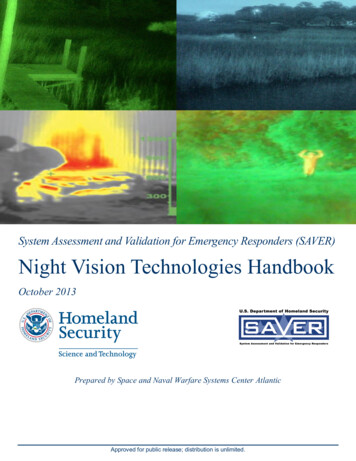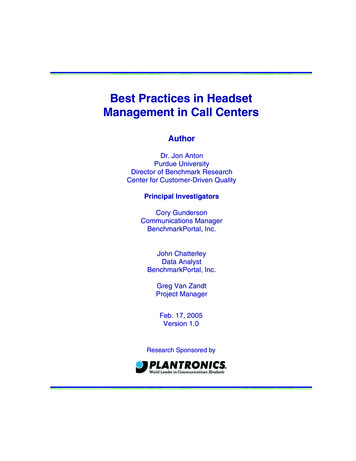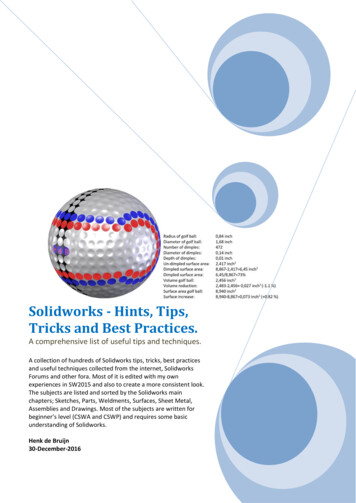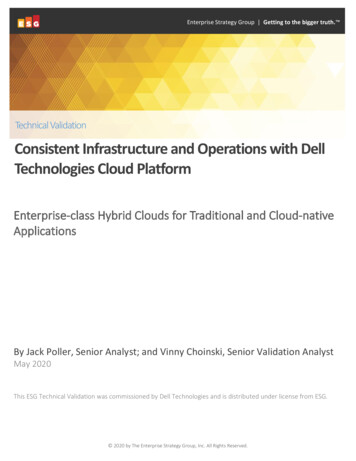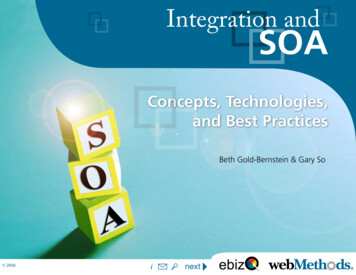
Transcription
Integration andSOAConcepts, Technologies,and Best PracticesBeth Gold-Bernstein & Gary So 2006next
About ebizQebizQ – The Insiders Guide to SOA and IntegrationebizQ is the leading community of business and IT executives, managers, architects anddevelopers focused on business integration and SOA. ebizQ’s analyst-centric multimediacontent includes interactive training, webinars, and analysis of industry trends and bestpractices. You can access daily aggregation of in-house and industry-wide blogs, breakingnews, feature articles and white papers.Learn more by visiting www.ebizQ.net and gain access to the following great content!Webinars: www.ebizQ.net/webinars/White Papers: www.ebizQ.net/white papers/Online Curriculum: www.ebizQ.net/trainingcenterBlogs: www.ebizQ.net/blogsCIO audio: www.ebizQ.net/executive corner/cioaudio/Buyers Guide: www.ebizQ.net/vendorsBring the rest of your team up to speed. Attend our online companion course, a Manager’sGuide to Integration and SOA: www.ebizQ.net/managersguide or call1-866-55-EBIZQ (1-866-55-32497)About webMethodsGet There Faster.webMethods provides total business integration to the world’s largest corporations andgovernment agencies. webMethods flagship product suite, webMethods Fabric, leveragesleading SOA and BPM technologies and methodologies to deliver rapid ROI to our 1,300customers around the globe. With webMethods, customers can take a process-centricapproach to their business problems, allowing them to re-use their existing IT assets,dramatically improve business process productivity and ROI, and rapidly create competitiveadvantage by making their business processes work harder for their company. webMethods(NASDAQ: WEBM) is headquartered in Fairfax, VA, USA and has offices throughout the UnitedStates, Europe, Asia Pacific and Japan.For more information on our company and our products, we invite you to visit our website,www.webMethods.comView our SOA webinar series – www.webMethods.com/Events/Web/GetRealwithSOALearn more about us – www.webMethods.com/AboutHear our vision – www.webMethods.com/VisionMeet our customers – www.webMethods.com/CustomersView our products – www.webMethods.com/ProductsIf you would like additional copies of the book, please email soabook@webMethods.com
Tables of ContentsChapter 1 The Business Imperative for Integration . . . . . . . . . . . . . . . . . . . . . . . . . . . . .Executive Overview . . . . . . . . . . . . . . . . . . . . . . . . . . . . . . . . . . . . . . . . . . . . . . . . . . . . . .Challenges to Business Agility . . . . . . . . . . . . . . . . . . . . . . . . . . . . . . . . . . . . . . . . . . . .The Mandate for Integration . . . . . . . . . . . . . . . . . . . . . . . . . . . . . . . . . . . . . . . . . . . . .Integration and SOA . . . . . . . . . . . . . . . . . . . . . . . . . . . . . . . . . . . . . . . . . . . . . . . . . . . . . .The Evolution of Integration . . . . . . . . . . . . . . . . . . . . . . . . . . . . . . . . . . . . . . . . . . . . .Integration: A Business Imperative . . . . . . . . . . . . . . . . . . . . . . . . . . . . . . . . . . . . . . . .How to Use This Book . . . . . . . . . . . . . . . . . . . . . . . . . . . . . . . . . . . . . . . . . . . . . . . . . . . .556610111214Chapter 2 Building the Business Case for Integration . . . . . . . . . . . . . . . . . . . . . . . . . . .Executive Overview . . . . . . . . . . . . . . . . . . . . . . . . . . . . . . . . . . . . . . . . . . . . . . . . . . . . . .Tangible and Intangible Benefits . . . . . . . . . . . . . . . . . . . . . . . . . . . . . . . . . . . . . . . . . .Areas for ROI . . . . . . . . . . . . . . . . . . . . . . . . . . . . . . . . . . . . . . . . . . . . . . . . . . . . . . . . . . . . .Defining Costs . . . . . . . . . . . . . . . . . . . . . . . . . . . . . . . . . . . . . . . . . . . . . . . . . . . . . . . . . . .Best Practices . . . . . . . . . . . . . . . . . . . . . . . . . . . . . . . . . . . . . . . . . . . . . . . . . . . . . . . . . . . .151516182527Chapter 3 Common Integration Scenarios . . . . . . . . . . . . . . . . . . . . . . . . . . . . . . . . . . . . .Executive Overview . . . . . . . . . . . . . . . . . . . . . . . . . . . . . . . . . . . . . . . . . . . . . . . . . . . . . .Data Synchronization . . . . . . . . . . . . . . . . . . . . . . . . . . . . . . . . . . . . . . . . . . . . . . . . . . . .Enterprise Application Integration . . . . . . . . . . . . . . . . . . . . . . . . . . . . . . . . . . . . . . . .Mainframe Integration . . . . . . . . . . . . . . . . . . . . . . . . . . . . . . . . . . . . . . . . . . . . . . . . . . .B2B Integration . . . . . . . . . . . . . . . . . . . . . . . . . . . . . . . . . . . . . . . . . . . . . . . . . . . . . . . . . .Single View of Information . . . . . . . . . . . . . . . . . . . . . . . . . . . . . . . . . . . . . . . . . . . . . . .Multichannel Access . . . . . . . . . . . . . . . . . . . . . . . . . . . . . . . . . . . . . . . . . . . . . . . . . . . . .Composite Applications . . . . . . . . . . . . . . . . . . . . . . . . . . . . . . . . . . . . . . . . . . . . . . . . . .Business Process Management . . . . . . . . . . . . . . . . . . . . . . . . . . . . . . . . . . . . . . . . . . .Business Performance Optimization . . . . . . . . . . . . . . . . . . . . . . . . . . . . . . . . . . . . . .Best Practices . . . . . . . . . . . . . . . . . . . . . . . . . . . . . . . . . . . . . . . . . . . . . . . . . . . . . . . . . . . .323233343638414446485052
Chapter 4 Guide to Integration Technologies . . . . . . . . . . . . . . . . . . . . . . . . . . . . . . . . . .Executive Overview . . . . . . . . . . . . . . . . . . . . . . . . . . . . . . . . . . . . . . . . . . . . . . . . . . . . . .Application Integration Services . . . . . . . . . . . . . . . . . . . . . . . . . . . . . . . . . . . . . . . . . .Information Integration Services . . . . . . . . . . . . . . . . . . . . . . . . . . . . . . . . . . . . . . . . . .Interface Integration Services . . . . . . . . . . . . . . . . . . . . . . . . . . . . . . . . . . . . . . . . . . . . .Composite Application Services . . . . . . . . . . . . . . . . . . . . . . . . . . . . . . . . . . . . . . . . . .Process Integration Services . . . . . . . . . . . . . . . . . . . . . . . . . . . . . . . . . . . . . . . . . . . . . .Business Optimization Services . . . . . . . . . . . . . . . . . . . . . . . . . . . . . . . . . . . . . . . . . . .Compliance and Industry Solutions . . . . . . . . . . . . . . . . . . . . . . . . . . . . . . . . . . . . . . .Management and Security . . . . . . . . . . . . . . . . . . . . . . . . . . . . . . . . . . . . . . . . . . . . . . .Architecture and Development . . . . . . . . . . . . . . . . . . . . . . . . . . . . . . . . . . . . . . . . . . .Conclusion . . . . . . . . . . . . . . . . . . . . . . . . . . . . . . . . . . . . . . . . . . . . . . . . . . . . . . . . . . . . . . .545454616365677072737374Chapter 5 Integration and SOA . . . . . . . . . . . . . . . . . . . . . . . . . . . . . . . . . . . . . . . . . . . . . . . .Executive Overview . . . . . . . . . . . . . . . . . . . . . . . . . . . . . . . . . . . . . . . . . . . . . . . . . . . . . .Why SOA? . . . . . . . . . . . . . . . . . . . . . . . . . . . . . . . . . . . . . . . . . . . . . . . . . . . . . . . . . . . . . . . .SOA Explained . . . . . . . . . . . . . . . . . . . . . . . . . . . . . . . . . . . . . . . . . . . . . . . . . . . . . . . . . . .The Role of Web Services . . . . . . . . . . . . . . . . . . . . . . . . . . . . . . . . . . . . . . . . . . . . . . . . .Enterprise-Class SOA . . . . . . . . . . . . . . . . . . . . . . . . . . . . . . . . . . . . . . . . . . . . . . . . . . . . .Best Practices in SOA . . . . . . . . . . . . . . . . . . . . . . . . . . . . . . . . . . . . . . . . . . . . . . . . . . . . .Conclusion . . . . . . . . . . . . . . . . . . . . . . . . . . . . . . . . . . . . . . . . . . . . . . . . . . . . . . . . . . . . . . .7575788083899596Chapter 6 Best Practices for Integration . . . . . . . . . . . . . . . . . . . . . . . . . . . . . . . . . . . . . . .Executive Overview . . . . . . . . . . . . . . . . . . . . . . . . . . . . . . . . . . . . . . . . . . . . . . . . . . . . . .Common Pitfalls . . . . . . . . . . . . . . . . . . . . . . . . . . . . . . . . . . . . . . . . . . . . . . . . . . . . . . . . .Taking a Strategic Approach to Integration . . . . . . . . . . . . . . . . . . . . . . . . . . . . . . . .Organizing for Success . . . . . . . . . . . . . . . . . . . . . . . . . . . . . . . . . . . . . . . . . . . . . . . . . . .Responsibilities of the ICC . . . . . . . . . . . . . . . . . . . . . . . . . . . . . . . . . . . . . . . . . . . . . . . .Creating an ICC . . . . . . . . . . . . . . . . . . . . . . . . . . . . . . . . . . . . . . . . . . . . . . . . . . . . . . . . . .Critical Success Factors . . . . . . . . . . . . . . . . . . . . . . . . . . . . . . . . . . . . . . . . . . . . . . . . . . .Conclusion . . . . . . . . . . . . . . . . . . . . . . . . . . . . . . . . . . . . . . . . . . . . . . . . . . . . . . . . . . . . . . .97979799100106109111113
5Integration and SOAExecutive OverviewService Oriented Architecture (SOA) is transforming IT, so it is important to understand the relationship between integration and SOA. This is not a straightforwardtask, however, because definitions and interpretations of SOA abound.From a software engineering perspective, SOA is simply an approach to software design that involves assembling systems from reusable components (services) that mayoriginate from different sources and underlying technology environments. At this level, SOA is often associated with Web services. However, Web services address only thelow-level interactions between services; they do not address the grander architecturaland design philosophies of SOA. In other words, SOA is about much more than justWeb services.From a broader IT perspective, SOA suggests a fundamental shift in how an organization implements business systems—with attendant changes in technology, methodology, and organizational structure. An even broader interpretation is that SOA marksthe end of monolithic enterprise applications and the beginning of more flexible andadaptable business process-centric applications.While definitions of SOA vary, there is unanimous agreement on SOA’s value and promise. The past decade has seen unprecedented leaps in computing. More and more aspects of a business use computers. Additionally, the Internet has extended system interfaces to include connections with trading partners. Not surprisingly, this has resulted inan unruly explosion of stovepipe applications, databases, and electronic connections.The challenge for IT today is to create and support an infrastructure that can harnessthese diverse assets and deliver on new business requirements more effectively. SOAprovides the basis for this infrastructure and offers the promise of tangible businessbenefits. SOA also makes it possible for organizations to leverage IT assets so they canrapidly deploy new business solutions as needed.75
Chapter 5Integration and SOAWith its promise of transforming the way systems are developed, SOA will benefit howorganizations approach integration. At a basic level, the growing adoption of Web services will improve system-to-system interoperability—making it simpler to connectsystems—while the componentization of business services will make it easier to create new business solutions from existing applications and retrieve information as thebusiness demands. At the same time, integration technologies play an important rolein the SOA portfolio, addressing needs such as service orchestration, service- and process-level monitoring, service management, and the ability to make legacy systemspart of the SOA environment. Clearly, integration and SOA are highly complementary,with SOA making it easier to integrate systems and business processes, and integrationtechnologies providing the essential technical infrastructure services required for SOAimplementations.Unlike previous IT revolutions that were accompanied by massive change, SOA enablesan evolutionary approach and the opportunity for organizations to move forward incrementally. The key to success is to plan strategically at an enterprise level and thenimplement tactically, with the appropriate best practices and governance policies andprocedures in place. This strategy delivers benefits along the way, making it easier tojustify SOA investments.This chapter explores the benefits, design concepts, technologies, and best practices ofSOA, and shows how they relate to integration.76
Case Study 5-1Company: WRA ElectronicsChapter 5Integration and SOACompany DescriptionWRA Electronics is a pseudonym for a Fortune 500 global provider of electronic componentsand computer products. The company serves as a supply channel partner for more than 500suppliers and 150,000 original equipment manufacturers, contract manufacturers, and commercial customers. Headquartered in New York, WRA employs more than 10,000 people inmore than 200 locations around the world.Business ChallengesAs a player in the global electronic equipment market, WRA is required to comply with RoHS,a European industry directive restricting the use of six hazardous substances in electrical andelectronic equipment. As part of the directive, WRA needed to make all relevant informationabout its products accessible to its customers for quoting, ordering, and purchasing decisions.However, different business processes (e.g., quoting and ordering) employed different subsystems running on different platforms and diverse technologies, and the global componentsdata was located in an Oracle database.How Integration Addressed the ChallengesWRA adopted an SOA strategy to address its requirements. Using webMethods as its SOAplatform, WRA was able to link its disparate systems using Web services and to provide aservice-oriented interface for consumer applications. The webMethods solution also providesconnectivity to WRA’s mainframe-based systems that currently cannot interoperate with Webservices. The RoHS Web service provides data from the Oracle database and plugs into the existing business processes for quoting and ordering. Any differences between the platforms arebridged using the Web service interface, and the webMethods platform performs all necessarymappings and transformations.Bottom-Line Business BenefitsWRA is now able to comply with the RoHS mandate. The new system provides global enterprise visibility into the company’s products and parts along with RoHS information. Eachmonth, more than 500,000 transactions pass through the company’s internal Web servicesintegration environment, and the RoHS Web service is utilized more than 80,000 times.In addition to complying with the directive, WRA has achieved significant cost savings andefficiency improvements with its SOA approach. The system has enabled the automation ofnumerous process steps, saving time and errors. Company sales personnel have also been ableto help customers make more informed purchasing decisions, increasing customer satisfaction.By providing its customers with quick and easy access to RoHS-related information, WRA hasgained a competitive edge in the market.77
Chapter 5Integration and SOAWhy SOA?SOA provides many benefits to both IT and the orga-nization at large. The most important benefit—and the one most often cited in relation to SOA—is reusability. SOAallows organizations to do more with the resources at their disposal. It promotes reusability by enabling services to be shared by different applications running on differentplatforms. Reusability creates a competitive advantage by providing greater flexibilityin the way computer systems can be used to support the business.Figure 5-1. Flexibility of SOA through reuseFor example, many organizations have stovepipe applications that address specific areas of business functionality, such as order processing, invoice handling, or customerrelationship management (CRM). Each application has its own customer data and itsown view of the customer. And each has local mechanisms for retrieving information,such as customer details, that were developed in the environment and technologyspecific to the application platform. In an SOA, these duplicated routines can be re-78
Chapter 5Integration and SOAplaced by a common reusable service (for example, FindCustomer) that delivers thesame functionality. Because there is just one copy of the FindCustomer service, changes need only be made in one place. This reduces application maintenance costs andenables new changes to be accommodated more quickly and easily.Another benefit of SOA is increased agility when addressing business opportunities orchanges in business requirements. By reusing common steps and developing only thenew steps that are required, organizations can more easily modify or enhance businessprocesses and applications when the need arises. For example, a company that offershome loans may have a loan approval process consisting of numerous SOA services.If the company now wants to offer car loans, it can reuse many components from theexisting implementation, such as checking current account details or market interestrates. This increased agility translates directly into increased competitiveness. Thus, organizations that master SOA will gain an advantage over those that do not.A third benefit of SOA is the reduced complexity from a more orderly enterprise architecture and development approach. Modular services enable a less-complex, divideand-conquer approach to software development. This enables SOA to accelerate thedeployment of new application functionality, decreases the testing effort by making iteasier to test individual components independently, and lowers implementation risksthrough the reuse of functionality that is already quality-tested and proven.Another benefit of SOA is increased IT adaptability. Packaged application implementations, custom-built solutions, and system changes resulting from mergers and acquisitions can be integrated more quickly and easily. SOA’s inherent platform-independentapproach provides organizations with more flexibility to use the software and hardware of their choice. This allows them to engage in a multisource strategy and reducesthe threat of vendor lock-in. For solutions developed in-house, it enables programmersto use their existing technical skill sets.79
Chapter 5Integration and SOAFigure 5-2. Adding new functionality easilyBest of all, these benefits can be realized quickly. SOA is ideally suited for incrementaldeployment, with investments made step-by-step for individual projects. Returns canalso be realized incrementally. This eliminates the need for costly and risky “big-bang”software implementations, reduces investment risk, and delivers value more quickly.Thus, SOA becomes a far more palatable investment for organizational decision makers.SOA ExplainedAlthough the term Service Oriented Architecture first emerged in the 1990s, the spiritof SOA existed long before that. The underlying principles of SOA—componentization, encapsulation, separation of interface from implementation, loose coupling, andso on—have been promoted since computing’s infancy. These design principles wereused in the days of centralized computing, when the focus was on IT resource optimization.80
Chapter 5Integration and SOAThen the landscape changed. On the technology side, the arrival of distributed computing offered great productivity and price performance, and the emergence of the Internet promised ubiquitous connectivity. On the business side, IT was increasingly seenas something that could be used for business advantage rather than just back-officeoperations. But these changes introduced considerable challenges in linking togetherdifferent technologies and platforms to utilize the increasingly diverse IT infrastructureto meet new business needs. The advent of object- oriented computing paved theway for SOA by introducing the concept of having discrete program components withstandard inputs and outputs that could be used to assemble applications.So what exactly is Service Oriented Architecture? From a software engineering standpoint, SOA is an IT architecture based on the delivery of reusable, well-defined business services underpinned by IT components in such a way that the providers and theconsumers of the business services are loosely coupled and have no knowledge of oneanother’s technologies, platforms, or locations.An explanation of the term “business services” is helpful here. With SOA, IT components are formed into services that are relevant to a particular business operation. Forexample, the service for FindCustomer might involve code that locates the customernumber by searching for the customer’s name in one system, then more code thatuses the customer number to query the customer’s service subscriptions in anotherapplication, and yet more code to retrieve the organization’s interaction history withthe customer from a third database.A service consists of a well-defined service interface and the service implementation.The service interface describes how to call the service. It specifies, among other things,the location of the service and the information required to make a request to the service and get a response. This is where Web services provide an ideal fit for SOA. The useof Web services ensures a standard protocol for communication between the serviceconsumer and provider and a standard way to define a service’s interface. It is basicallyan electronic description of how to call the service from other programs.The service implementation is the actual code that fulfills the functionality of the service. It is the logic that resides on computers somewhere on the network and executes81
Chapter 5Integration and SOAwhen the service is called, subject to appropriate security constraints. The service implementation is inherently platform-dependent. However, SOA is not concerned withhow services are implemented. Architecturally, it does not matter, for example, whetherthe FindCustomer service is written in Java, C#, or COBOL. The only thing that mattersis that the service fulfills the behavior specified by its interface.Another important term used when defining SOA is “loose coupling.” Services that areloosely coupled can be invoked by any application on any platform in any location. Allthe calling application needs to know is how to invoke the service, and any inputs andoutputs required. This enables the interoperation of different applications and serviceswritten in different languages with different development tools and platforms. Loosecoupling also means that one service can be replaced by another—provided it has thesame signature (inputs and outputs)—without impacting any of the other connectedservices or requiring them to be modified. That means incremental changes to a system can be made without having to redevelop the entire application. The dynamicnature of SOA is another important distinction from more traditional application development approaches.A final consideration when thinking about SOA is “granularity.” Granularity refers tothe level of functionality provided by a service. A fine-grained service (such as VerifyZipCode) performs a very specific and discrete function, while a course-grained service (such as ProcessInvoice) incorporates more functionality and typically maps moreclosely to the notion of a business service. This distinction sets SOA apart from previouscomputing paradigms by providing a common language for IT and the line of business to discuss computing requirements. Rather than talking about low-level bits ofprogramming code, SOA allows application requirements to be expressed in terms ofmodular, reusable business services. At a technical level, SOA enables services to bemade up of other services, which makes it possible to assemble course-grained services that map to useful business functions. An important goal when designing servicesis to encapsulate business functionality at an appropriate level of granularity so it canbe reused across different solutions.82
Chapter 5Integration and SOAThe Role of Web ServicesAs mentioned, SOA is often discussed in conjunction with Web services, but the twoare not synonymous. In theory, SOA does not require Web services, and simply implementing Web services does not result in an SOA. However, Web services are the firststandard for service-oriented computing to gain the near-universal support of software vendors, end-user organizations, and standards organizations. By standardizingessential elements of SOA, Web services remove the risk of having to bet on a particulartechnology (as was the case with CORBA in the days of distributed computing). As aresult, Web services and their related standards are driving the widespread adoptionof SOA.The Web services standards define XML-based protocols and interface descriptionsthat enable services to interact. Basic Web services standards include Simple ObjectAccess Protocol (SOAP), Web Services Description Language (WSDL), and Universal Description, Discovery, and Integration (UDDI).XML, or Extensible Markup Language, is a World Wide Web Consortium (W3C)-recommended standard for defining different types of data. XML provides a text-based wayto describe and apply a tree-based structure to information. It has several advantagesover previous approaches to describing data: It is readable by humans and machines, itis platform-independent, and it has the flexibility to handle arbitrary types of data anddata structures. Propelled by the adoption of the Internet and open standards, XML hasemerged as the critical standard for data definition and document markup.SOAP is a lightweight protocol intended for exchanging XML-based messages in adecentralized, distributed environment, normally using HyperText Transfer Protocol(HTTP), the protocol used between Web servers and browsers on the Web. HTTP waschosen as the primary application-layer protocol for SOAP because it works well withtoday’s Internet infrastructure and is firewall friendly—unlike other distributed computing protocols, which are generally filtered out by firewalls.83
Chapter 5Integration and SOAA SOAP message consists of a one-way transmission from a SOAP sender to a SOAPreceiver. Applications can use SOAP to create more complex interaction patterns, including request/response and multiple, back-and-forth (conversational) exchanges.The most common pattern is the remote procedure call (RPC) or request/reply pattern, where one program (the client) sends a request message to another program (theserver), and the server immediately sends a response message to the client.WSDL is an XML-based format for describing Web services. WSDL defines the publicinterface to a Web service, which describes how to communicate with the Web serviceas well as the operations and messages supported by the Web service. WSDL is typically used in combination with SOAP. A client program reads a Web service’s WSDL todetermine what functions are available on the server, and then uses SOAP to actuallycall one of the functions listed in the WSDL.UDDI is an XML-based standard for a Web services registry (i.e., directory) that allowsservice providers to publish information about their services and enables potentialservice consumers to browse listings of available services (using SOAP messages) toidentify the ones most suited to their application requirements. As such, UDDI is oftendescribed as a Yellow Pages for Web services. Originally intended as a public resource,UDDI is now more commonly used within organizations as a private registry of theirinternal Web services.Additional Web services standards are being developed in areas such as security, reliable message delivery, and transactions. Standards are also being created to definethe business process flow across services (for example, BPEL, which was discussed inChapter 4). Unfortunately, as history has taught us, standards alone do not guaranteeinteroperability. Vendors may implement subsets of the standards for expediency, orsupersets of the standards for enhanced functionality, but these subsets and supersetsmay actually limit interoperability.84
Chapter 5Integration and SOAFigure 5-3. How Web services standards interactTo guard against interoperability issues and the potential slowdown in Web servicesadoption that might result, the vendor community has formed the independent WebServices Interoperability Organization (WS-I). WS-I’s charter is to promote the interoperability of Web services implementations from different vendors. WS-I creates profiles,which are implementation guidelines for interoperability, and testing tools to verifyconformance with a profile and WS-I guidelines. Currently available profiles include theBasic Profile, Attachments Profile, and Simple SOAP Binding Profile. In addition, work isunder way on a Basic Security Profile. WS-I profile conformance is an important consideration for organizations that want to ensure interoperability of their Web servicesacross different vendor platforms.85
Case Study 5-2Company: U.S. Power & LightChapter 5Integration and SOACompany DescriptionU.S. Power & Light is a pseudonym for one of the country’s largest power providers. Thecompany manages a distribution grid that spans 11 states and provides electricity to 5 millioncustomers.Business ChallengesSeveral years ago, the Federal Energy Regulatory Commission mandated that U.S. Power &Light become a member of a regional transmission organization (RTO). RTOs are independent, government-regulated organizations focused on energy transmission and distributionfor regions of the country. U.S. Power & Light needed to meet the RTO’s stringent technicalrequirements in 10 months, or it risked fe
implement tactically, with the appropriate best practices and governance policies and procedures in place. This strategy delivers benefits along the way, making it easier to justify SOA investments. This chapter explores the benefits, design concepts, technologies, and best practices of





